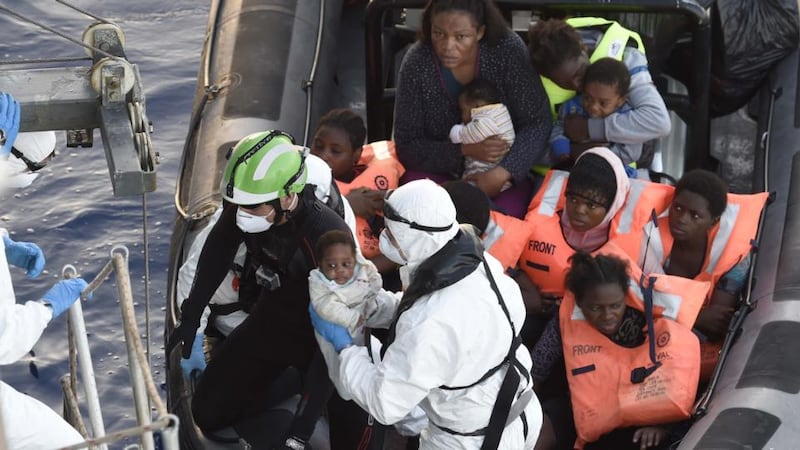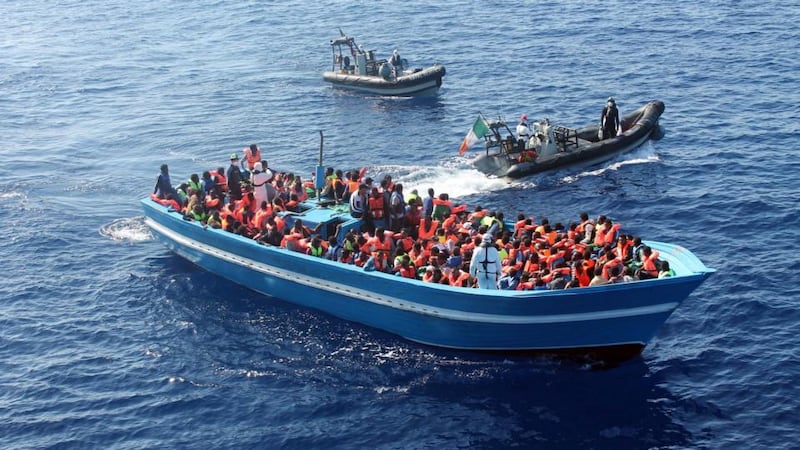Leading sick berth attendant Alan Cummins won't forget the first rescue mission which the LÉ Éithne undertook in the Mediterranean in a hurry.
“It was 0200 hours – the middle of the night – and the first sight I had as we approached was of a woman in the middle of a barge holding up a baby,” he said. “I think there were about 30 kids among 300 on board this wooden barge, and we were trying to calm the whole situation. We were advised to throw the life jackets to them first, as otherwise there could be a mad rush to one side of their boat. We had to explain a few times that there was a life jacket for everyone.”
Leading seaman Cummins, from Bishopstown, Cork, was one of two medical staff on board, along with Army colleague Pte Sonya Larrigan from Dundalk, Co Louth. His job, and that of Larrigan, was to undertake initial "triage" at sea to assess the most pressing cases requiring medical attention.


Chemical burns were among the most frequent injuries, due to leaking fuel on the overcrowded craft, he said. A makeshift hospital was set up on the afterdeck of the ship, and victims constantly monitored.
He also treated several people with bruises and fractures, sustained when smugglers held people in a warehouse in Libya.
“At first people are reluctant to talk – and very traumatised – but gradually you build up their trust,” he said.
Provision of water, rations and rehydration tablets were the first priority when people were taken on board the ship, and many were "emotionally drained". Witnessing a group of Eritrean men praying facing Mecca on mats on the deck of the LÉ Éithne was one of many emotional moments for the 69-strong crew, according to Lieut Shane Mulcahy, the Eithne's search and rescue co-ordinating officer, who briefed journalists on the logistics of some 22 rescues of almost 3,400 people.
An Irish ability to deal with people, in spite of language barriers, was an enormous benefit, he said – even though the first sight migrants had of Naval Service personnel was of them shrouded in white personal protection suits and masks to protect against possible diseases.
Traumatised people
There was “some level” of armed personnel on call in case of security issues, but “there was nothing we had to use”, Lieut Mulcahy said. It became clear most of those rescued were very traumatised, but all taken on board were “frisked”.
Cook Paul O’Shea from Cobh said he often thought of his two-year-old daughter Caoimhe at home with his wife Ciara, when hearing small children crying on deck. Migrants were fed every four hours, with vegetarian meals – pasta, rice and sauce. Some 2,900 meals were prepared, including for the ship’s crew, he said.
During one of the largest rescues, of 650 people, when the entire deck and foc’sle was covered with migrants sleeping with emergency blankets, the galley was “hectic”, he said: “There were times when the cookers were going 16 hours a day.”
Over 5 per cent of those rescued were infants, and children tended to be with their mothers. Migrants spent anything between 12 hours and five days on vessels, with up to 350 on wooden barges, and over 100 on rigid inflatables. Once migrants were taken from the craft, the vessels were sunk to ensure they were not a hazard to navigation, said Lieut Mulcahy.











